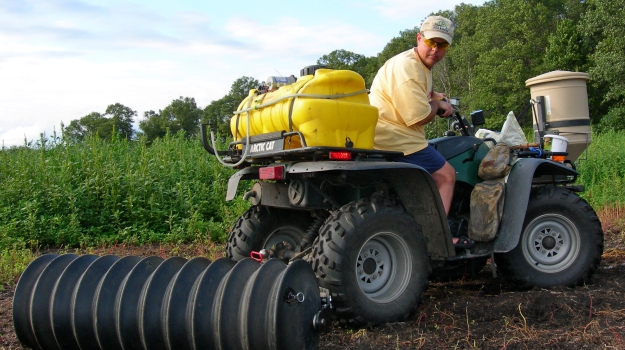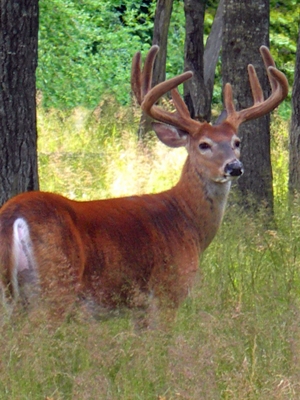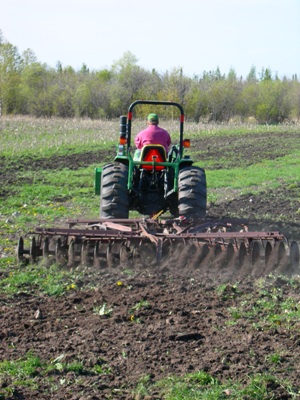
Listen to the People Who Make Their Living Doing It
By Todd Amenrud
“Why do the same thing and expect different results?” Many novice land managers will have food plot failures this year. Next year, they’ll go out and plant the same thing, the same way and expect it to work. I’m sorry, but there are no “magic beans!” Yes, Mother Nature has a lot to do with food plot success, but “know-how” is the unambiguous solution when it comes to planting seeds. If you do things right you can actually battle Mother Nature for respectable food plots even under somewhat adverse conditions.
Trial and error can be an expensive and time consuming approach to this venture…- I can tell you that from experience. In my view the most precious loss is you have to wait an entire year to try again if you get it wrong. Many years ago I was one of those stubborn, uneducated land stewards. I wasted a lot of time and money on things I “thought” would be good for my deer herd because “I knew best.” Some things worked, many did not. I can say now after taking the time to study, “education” is a main component to being a successful land manager.
Following are ten tips from the people who know the answers. They all make their living from the food plot seed trade, land management or the hunting industry. Most are also well known in the “food plot circuit.”
Jordan LaSuzzo
Habitat Specialist for Mossy Oak BioLogic
Take the Food to the Deer
 Mature bucks are often hard to see out in a major agricultural food source during legal shooting time. Those big guys seem to hang in the shadows and appear after dark. I would suggest that people bring the food source closer to the bedding areas. Place your plots in areas where even mature bucks will feel comfortable about being during daytime hours.
Mature bucks are often hard to see out in a major agricultural food source during legal shooting time. Those big guys seem to hang in the shadows and appear after dark. I would suggest that people bring the food source closer to the bedding areas. Place your plots in areas where even mature bucks will feel comfortable about being during daytime hours.
I classify my plots into either a “feeding plot” or a “hunting plot.” My feeding plots are relatively large in comparison to those I regularly hunt. My goal with this type of plot is to provide as much nutrition to as many deer as possible. I usually don’t hunt these plots, but there are exceptions to the rule.
On the other hand, I have my “hunting plots” or “harvest plots.” Here, I search for those smaller hide-a-ways that get at least 5 hours of sunlight but also have great security-cover and bedding areas close by. A mature buck will feel safer accessing these out of the way spots during shooting hours.
When designing the plot consider wind direction and thermal current. Also consider which crops to plant. In a hunting plot I want those “candy crops,” they can’t resist. Make sure you plant crops that will be at the peak of their attraction when you want to hunt the spot. If you plan things right you can harvest mature bucks right in your food plots if you bring the food closer to them.
Steve Hickey
National sales Manager, Chapin Manufacturing
Quality Seed and Blends beat Cheap Seed and Mono-Plots
Most low-end, low-cost food plot seeds also deliver low performance. Many are agricultural-grade seeds such as milo, rye or commodity clovers that are bred primarily for consumption by livestock. Choose a blend consisting of “forage-grade cultivars,” which means the plants are bred specifically for consumption by deer. They were developed after many years of research, searching for the highest performing characteristics, and therefore will execute much better than generic commodity seeds that likely cost less. It really doesn't matter how inexpensive the seeds are if the plot doesn't grow well, it isn't palatable or doesn't attract deer.
Many consumers consider the cost of seed while it is sitting on the store shelf and don’t think beyond that point. You actually don’t save money by purchasing cheap seed! There are reasons why it’s cheaper. Probably the biggest reason is because it doesn't have one or more of the desirable characteristics wanted for the end result that it's being sold for. Let’s take clover as an example - so you plant cheap clover in plot A and clover that cost a bit more (but is the right stuff for the job) in plot B. You believe you've saved money in plot A. But it’s actually the opposite - the clover in plot B is going to produce tons and tons more forage, it’s better for your herd, they gain more from it because it’s easier for them to digest, it’s been treated with a coating to help it perform better from germination throughout the growing process and it will last several years longer. Figure all that into the cost!
It is generally best to plant a food plot that is a “blend” of several types of seeds. Plots that consist of just one type of seed (mono plots) are generally at much higher risk for failure. They typically do not perform as well in a wide variety of soil types, are more susceptible to heat and drought and are usually more prone to have disease and pest problems. Why? Because if a mono plot experiences just one of these problems, it affects the entire plot because there's only one type of plant in the field. You're essentially "putting all your eggs in one basket" if you plant just one type of seed.
Food plots consisting of several types of “quality” seeds have a much lower risk of plot failure. Each type of plant in the blend has a different tolerance level for soil type, heat resistance, drought tolerance, and disease or pest problems, not to mention possible poor farming practices. Multiple seed type plots manage these risks better, resulting in a better performing food plot.
Mike Berggren
Habitat Specialist, Manages 5 properties throughout the Midwest
You Must Give Them a Place to Live
By planting food plots you will increase the carrying capacity of your property. However, even if you have the best food plots in the county, if you don’t give your deer a place to live don’t expect to see a dramatic increase in herd numbers.
Through woods-work and planting certain cover crops you can create “housing” for them. Remember, their world exists from six feet high to the ground. If while standing on the ground you can see 100 yards or more through the trees, your property isn’t holding a lot of deer. You don’t want your property to look like a park you want thickets that create the edge cover and diversity whitetails are attracted to.
Taking it a step further, you should have sanctuaries for them - a spot that is off limits to everyone. This is especially important if you want to hold mature bucks on your land. The size and amount of these “safe heavens” should be relative to the size of the property. A five acre sanctuary is large enough to house a mature buck but larger is better. I have sanctuaries that are anywhere from 10 acres in size on up to one that is approximately 300 acres. Typically, the thicker the cover the more deer it will hold.
Austin Delano
Food Plot Expert, Southern Whitetail Habitat and Hunting Specialist
Location, Location, Location
As with most successful businesses, location is a key factor in the overall success of the organization. Likewise, site selection is a major contributor to your overall food plot success. Some spots simply are not meant to grow a crop. In turn, there can be some great spots you may be overlooking right under your nose.
One should develop a true written plan on the location and design of the plot. The individual's food plot intent should drive the site location. For instance, for individuals wanting to provide a late season food plot for deer, the plot location should be adjacent to key wintering areas, thus minimizing travel times and energy expenditure. For other individuals, a harvest plot is the focus. Thus a significant amount of time should be placed on site location to ensure that wind and game access routes are to their advantage.
If you are unsure on site selection hire a consultant who can assist with the process. It can get costly to expend considerable resources on a plot that is destined not to perform to your standards simply because of location.
Dr. Grant Woods
GrowingDeer.TV
Don’t Be a Weed Seeder
If you use a rotary style mower, you know that grass and weed clippings accumulate on the deck as you mow. What most of us don’t think about is that these clippings are essentially a “seed bomb” waiting to be deployed.
If you’re heading to mow areas that are being used as, or prepared for food plots, do yourself a favor and clean off the mower deck. Otherwise, as the weed cuttings slide or blow off the mower deck, you are effectively seeding the plot with weeds that you will have to fight later.
David Westmoreland
Habitat Specialist, Manages over 12,000 acres throughout the Midwest
"Be effective with herbicides"
By planning ahead and preparing your food plot areas properly with chemical applications you can save a ton of time and money. With the selective and non-selective herbicides available today you can manage the weeds and grasses long before you plant your food plot. Proper herbicide timing can also save banked moisture and valuable soil nutrients and microorganisms.
I have found it is faster and more efficient to spray thoroughly then allow ample time for the vegetation to breakdown before attempting to work the soil. Once the vegetation has broken down, seed to soil contact is a breeze and the overall competition of undesirable plants has been eliminated. This also gives your planting a jump start against any kind of volunteer plants that may want to take over the food plot. This method also provides a much longer life to your food plots by eliminating the weeds and grasses before you start.
I spend much of the spring and early summer driving around the farm spraying and planning what I can plant for the coming fall. I have even sprayed an area in the spring or summer and then simply frost-seeded clover the following spring with excellent results! It is an instant clover food plot without ever turning over a bit of dirt! No tractor required!
Mark and Terry Drury
Drury Outdoors, TV Hosts
Keep Food on the Table All Season
Many managers design their hunting plots and don’t put much thought into timing. They may plant brassicas in one plot, soybeans in another and cereal grains in a separate spot. These plots will all be hot at one time or another but after they peak you may as well hang your treestand somewhere else. There are going to be a few days where you can’t keep them out of the cereal grains, but then they run their course and your herd will be on to something else.
Various plants mature at different rates and become palatable at different times. This is one reason food plot seed companies sell “blends” rather then single crops. If you have enough acreage to plant you want to have an appealing food for them throughout the entire hunting season.
It’s important to have a diverse forage base for them. We like to plant both annuals and perennials in most areas. Both types have desirable health characteristics and act as attraction at various times of the hunting season.
In addition, rather than planting just one seed blend, we would recommend planting several blends. Don’t mix them together, they are already “blends,” rather plant the blends separately in their own spot in the plot.
Whitetails are very selective feeders. One day they might be on chicory and then a big temperature change comes through and they may switch to grains. Make sure you’re covered for the change. If you plan out what to plant you can have a selection of something palatable for them to last throughout the entire season regardless of the conditions all in one plot.
Kurt Amundson
Land Manager & Habitat Consultant
Don’t Even Think about NOT doing a Soil Analysis
In my business I get to talk with many people about the successes and failures they have with their food plots. When trying to dig to the bottom of the failures I need to find the answers to many questions. Much of the information should be contained in a soil analysis. When asking for the results of the analysis the person with the failure will usually answer, “What soil test? I didn’t do one.” Despite the obvious benefit, people often forgo this critical step which often leads to their downfall.
You need to know what you’re up against so you know what to add or adjust for success. Without taking a soil sample you can only guess. It’s one of the most overlooked parts of the planting process, yet it will save you more time and money then any other detail.
The fastest, easiest, cheapest soil analysis that I’ve ever used is located at www.plantbiologic.com. Click on the “Soil” tab and the rest is easy.
Kevin Small
KTS Hunts, Scottland County MO, Manages 6,500 Acres
Don’t Bury Them Alive
 In days past I was guilty of wasting a lot of time, money and seed. After working my seed bed I would broadcast my seed and then cover it up. Covering it up, or should I say the way I covered it and to the extent I covered it, was my mistake. I would take the disk and run back over the plot again, or try and use a drag created with a bunch of lumber or log to bury the seed. Little did I know I was covering up most of the seed much too deep.
In days past I was guilty of wasting a lot of time, money and seed. After working my seed bed I would broadcast my seed and then cover it up. Covering it up, or should I say the way I covered it and to the extent I covered it, was my mistake. I would take the disk and run back over the plot again, or try and use a drag created with a bunch of lumber or log to bury the seed. Little did I know I was covering up most of the seed much too deep.
Many of the seeds that grow some of the whitetails’ favorite foods are small, tiny seeds that you can fit under your fingernail. People fail to realize that seeds are living organisms. A small seed such as a clover, brassica or chicory only contains a small amount of energy. The seed needs moisture to release its energy. If a small seed like this is buried any more then approximately ¼ of an inch it runs out of energy before it can reach the surface and begin to create its own energy through photosynthesis. Obviously, larger seeds, such as corn, beans or peas, contain more energy so they can, and should, be buried deeper.
I have learned these small seeds only need to make contact with the soil. If you’ve worked the soil by disking or tilling you probably don’t need to do anything at all, just the soil settling should “plant” the seeds for you. Planting before a rain is also a great option. The ultimate would be to use a cultipacker or some type of a roller to ensure good seed to soil contact, but DO NOT cover the seed too deep.
Duane Domaszek
Zoo Owner, Whitetail Nutrition Specialist
Let it “Simmer” a While
So many hunters want to grab a bag of seed, rush to the woods, scratch some soil and throw their seed on the ground. The uninformed weekend warrior who doesn’t have a plan will most likely not be satisfied with their results. One should consider their goals, budget, timeline and access to equipment before hastily heading afield and know that results are not going to happen overnight.
Being a GameKeeper isn’t a “task,” it’s a “way of life.” This isn’t a “one and then you’re done thing,” this is a devotion; it’s a dedication, an on-going accumulation! Committing to being a Gamekeeper or practicing QDM (like it should be practiced) is a “body of work.” You constantly learn more and apply those techniques and it continuously makes things better.” It’s something that once you commit to, the results can come within months, or it may take a couple years. But with something so grand I would consider that “relatively fast.” With a proper plan, if you stick to it, things just keep getting better and better.
Those who are in a rush should understand that being a whitetail manager and a land steward is an ongoing endeavor and most goals you can’t obtain overnight. You do what you can now and add to it as you go. With a sound plan, over time you can develop your own whitetail hunting paradise.



























